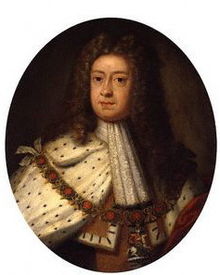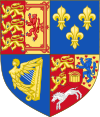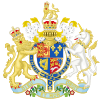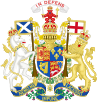- House of Este
-
"Este" redirects here. For the city, see Este, Italy. For the proto-historic culture of Veneto, see Este culture. For J. R. R. Tolkien's fictional character, see Estë.
The House of Este (
 /ˈɛsti/) is a European princely dynasty. It is split into two branches; the elder is known as the House of Welf-Este or House of Welf historically rendered in English, Guelf or Guelph. The younger, as the House of Fulc-Este or later simply as the House of Este.
/ˈɛsti/) is a European princely dynasty. It is split into two branches; the elder is known as the House of Welf-Este or House of Welf historically rendered in English, Guelf or Guelph. The younger, as the House of Fulc-Este or later simply as the House of Este.The elder branch of the House of Este included the dukes of Brunswick and Lüneburg (1208–1918) and produced England's Hanoverian monarchs.
The younger branch of the House of Este included rulers of Ferrara (1240–1597), and Modena and Reggio (1288–1796).
Contents
Origins
The origins of the family, probably of Frankish nobility, date back to the time of Charlemagne in the early 9th century when they settled in Lombardy. The first known member of the house was Margrave Adalbert of Mainz, known only as father of Oberto I, Count palatine of Italy, who died around 975. Oberto's grandson Albert Azzo II, Margrave of Milan, (996–1097) built a castle at Este, near Padua, and named himself after it. He had 3 sons from two marriages, two of whom became the ancestors of the two branches of the family:
- Welf IV, the eldest (d. 1101), was the son of Kunigunde (d. 1056), the last of the Elder Welfs. He inherited the property of his maternal uncle, Welf, Duke of Carinthia, became duke of Bavaria in 1070, and is the ancestor of the elder branch, the House of Welf.
- Hugh, issue of Azzo's second marriage to Garsend of Maine, inherited the County of Maine, his mother's dowry, but sold it one year later and died without heirs.
- Fulco I (d. about 1128/35), the third son, is the ancestor of the younger Italian line of Este.
The two surviving branches, with Duke Henry the Lion of Saxony and Bavaria on the German side, concluded an agreement in 1154 which allocated the family's Italian possessions to the younger line, the Fulc-Este, who in the course of time acquired Ferrara, Modena and Reggio. Este itself was taken over in 1275 by Padua and in 1405 (together with Padua) by Venice.
Elder branch, Guelph, Electors of Hanover
 George, by the Grace of God, of Great Britain, France and Ireland, King, Defender of the Faith, Prince-Elector of Hanover, Duke of Brunswick. ca. 1714, the year of his succession, by Sir Godfrey Kneller.
George, by the Grace of God, of Great Britain, France and Ireland, King, Defender of the Faith, Prince-Elector of Hanover, Duke of Brunswick. ca. 1714, the year of his succession, by Sir Godfrey Kneller.
The elder branch of the House of Este, the House of Welf, historically rendered "Guelf" or "Guelph" in English, produced dukes of Bavaria (1070–1139, 1156–1180), dukes of Saxony (1138–1139, 1142–1180), a German King (1198–1218), and the dukes of Brunswick and Lüneburg (1208–1918), later styled the "Electors of Hanover" when two branches of the family recombined in 1705.
After the peace ending the Napoleonic wars reshaped Europe ushering in the Modern era, the Electorate of Hanover (duchy of Brunswick and Lüneburg held in personal union by the king of Great Britain, George III) was dissolved by treaty, its lands were enlarged, and the state promoted to a kingdom. The new kingdom existed from 1815 to 1866, but upon accession of Queen Victoria (who could not inherit Hanover under the Salic law) in 1837, it passed to her uncle and thus ceased to be in personal union with the British Crown.
The House of Este hence gave Great Britain and the United Kingdom the "Hanoverian monarchs" (1714–1901).
Younger branch, the Margraves of Este
All later generations of the Italian branch are descendants of Fulco d'Este. From 1171 on, his descendants were titled Margraves of Este.
Obizzo I (d. 1193), the first margrave, battled against Emperor Frederick I Barbarossa. His nephew Azzo d'Este VI (1170–1212) became podestà of Mantua and Verona. In 1146 with the last of the Adelardi Ferrara passed as the dowry of his niece the Marchesella, to Azzo VI d'Este. Azzo VII Novello was nominated podestà for his lifetime in 1242.
The lordship of Ferrara was made hereditary by Obizzo II (d. 1293) who was proclaimed Lord of Ferrara in 1264, Lord of Modena 1288 and Lord of Reggio 1289. Ferrara being a papal fief, the Este family were given the position of hereditary papal vicars in 1332.
Ferrara became a significant center of culture under Niccolò d'Este III (1384–1441), who received several popes with great magnificence, especially Eugene IV, who held a Council here in 1438, later known as the Council of Florence.
His successors were Leonello (1407–1450) and Borso (1413–1471), who was elevated to Duke of Modena and Reggio by Emperor Frederick III in 1452 and in return received these duchies as imperial fiefs. In 1471 he received the duchy of Ferrara as papal fief from Pope Paul II, for which occasion splendid frescoes were executed at Palazzo Schifanoia.
Under Ercole (1431–1505), one of the most significant patrons of the arts in late 15th and early 16th century Italy, Ferrara grew into a cultural center, renowned especially for music; Josquin Des Prez worked for Duke Ercole, Jacob Obrecht came to Ferrara twice, and Antoine Brumel served as principal musician from 1505. Ercole's daughter Beatrice (1475–1497) married Ludovico Sforza, Duke of Milan, while his daughter Isabella (1474–1539) married Francesco Gonzaga, Marquess of Mantua.
Ercole I's successor was his son Alfonso I (1476–1534), third husband of the notorious Lucrezia Borgia and the patron of Ariosto.
Alfonso and Lucrezia Borgia's son Ercole d'Este II (1508–1559) married Renée of France, daughter of Louis XII of France. His son Alfonso II first married Lucrezia, daughter of grand-duke Cosimo I of Tuscany, then after becoming a widower, Barbara, the sister of Maximilian II, Holy Roman Emperor (1527–1576) and finally a third wife, Margherita Gonzaga, daughter of the duke of Mantua.
Though he raised the glory of Ferrara to its highest point, and was the patron of Torquato Tasso and Giovanni Battista Guarini, favouring the arts and sciences, as the princes of his house had always done, the legitimate line ended in 1597 with him. Emperor Rudolph II recognized as heir his first cousin Cesare d'Este (1533–1628), member of a cadet branch born out of wedlock, who continued to rule in the imperial duchies and carried on the family name. Ferrara, on the other hand, was annexed by force of arms in 1598 by Pope Clement VIII, on grounds of the heir's illegitimacy, and incorporated into the Papal States.
The last duke, Ercole III, was deposed in 1796 by the French and his two duchies became the Cispadane Republic which one year later was merged into the Cisalpine Republic and then into the Napoleonic Kingdom of Italy. Ercole was compensated in 1801 with the small principality of Breisgau in southwestern Germany, whose previous rulers, the Habsburgs, ceded it to him in anticipation of its eventual return to the Habsburgs, since Ercole's daughter Maria Beatrice Ricciarda d'Este was married to a cadet Habsburg, Archduke Ferdinand of Austria-Este. Ercole died in 1803 and Breisgau passed to his daughter and her husband, who then (1806) lost it during the Napoleonic reorganization of the western territories of the defunct Holy Roman Empire to the enlarged and elevated Grand Duchy of Baden.
Austria-Este and the House of Habsburg
In 1814, when French rule in Italy ended (but after the death of Duke Ercole), Modena was returned to his daughter Mary Beatrice and her son, Archduke Francis of Austria-Este. The family thus ruled the duchy of Modena and Reggio again from 1814 to 1859, using the names Asburgo-Este (Habsburg-Este) and Austria-Este. In 1859 the duchy lost its independence to the new united Italy, and Francis V, Duke of Modena, was deposed.
The family of Austria-Este became extinct in the male line with the death of Francis V in 1875. His blood-heiress was his niece, Archduchess Maria Theresia of Austria-Este (d. 1919); she and her husband, Prince Louis of Bavaria, later became Queen and King of Bavaria. The present head of this branch of the family is Franz, Duke of Bavaria.
However, Francis V had decided to retain the Este name in the Habsburg family and willed his inheritance to the line of Archduke Charles Louis, younger brother of Emperor Francis Joseph, on condition that the heir use the name Austria-Este. The first "adoptee" was Archduke Franz Ferdinand of Austria (b. 1863, not descended from Maria Beatrice Ricciarda d'Este), who took the name Austria-Este and in 1896 became the heir presumptive of the Habsburg Empire, but was murdered on 28 June 1914 in Sarajevo.

Since his own children were born in morganatic marriage (Sophie, Duchess of Hohenberg), the Habsburgs designated his soon-to-be born great-nephew Robert (b. 8 February 1915), second son of the future emperor Charles, as the next "adopted Austria-Este". Through his mother Zita of Bourbon-Parma (a great-granddaughter of Maria Teresa of Savoy, Duchess of Lucca and Parma, who was a daughter of Maria Teresa of Austria-Este, Queen of Sardinia, who in turn was a daughter of Maria Beatrice Ricciarda d'Este and Archduke Ferdinand of Austria-Este, Duchess and Duke of Breisgau and Modena), Robert was a descendant of Ercole III d'Este, and the blood of last Este dukes thus joined again with the name Austria-Este.
Today, the bearer of this tradition is the eldest son of Archduke Robert of Austria-Este (1915-1996), Lorenz Otto Charles of Austria-Este (b. 1955), who is married to Princess Astrid of Belgium, the only daughter of King Albert II. In 1995, Lorenz received the additional title of Prince of Belgium. Since 1991 the couple's children are titled Archduke (Archduchess) of Austria-Este, Princes(ss) of Belgium, Prince(ss) Imperial of Austria, Prince(ss) Royal of Hungary and Bohemia. Eldest of these is Prince Amedeo, Archduke of Austria-Este (b. 1986).
See also
- Bradamante who with Rogero are legendary ancestors of the House of Este
- Castello Estense
- Duchy of Reggio
- Duchy of Modena and Reggio
- Duchy of Massa and Carrara
- Ferrara
- Ivan VI of Russia
- List of Dukes of Ferrara and of Modena
- List of members of the House of Este
- Modena
- Reggio Emilia
- Romagna
Further reading
- Trevor Dean, Land and Power in Late Medieval Ferrara: The Rule of the Este, 1350–1450.(Cambridge University Press) 1987.
External links
- Il Castello Estense: genealogical tree
-
Coat of Arms of Austria-Este
1st Generation Alfonso I, Duke of Modena · Ippolito, Cardinal d'Este · Prince Ferrante · Prince Sigismondo · Prince Alberto · Ercole, Signore of San Martino2nd Generation Prince Alessandro · Ercole II, Duke of Modena · Prince Alessandro · Francesco, Marquis of Massalombarda · Prince Alfonso · Alfonsino, Marquis of Castelnuovo · Sigismondo, Signore of San Martino · Ippolito, Cardinal d'Este
3rd Generation Prince Alfonso · Alfonso II, Duke of Modena · Cesare, Duke of Modena · Luigi, Cardinal of Ferrera · Prince Alessandro · Filipo, Marchese of San Martino4th Generation Alfonso III, Duke of Modena · Prince Cesare · Prince Obizzo · Prince Cesare · Prince Rinaldo · Prince Borso · Prince Ippolito · Prince Foresto · Prince Bonofazio · Prince Rinaldo · Prince Filiberto · Luigi, Lord of Montecchio and Scandiano · Sigismondo, Marchese of Lanzo and Borgomanero5th Generation Francesco I, Duke of Modena · Filippo Francesco, Marquess of Lanzo · Carlo Emanuele, Marquess of Lanzo6th Generation Alfonso IV, Duke of Modena · Rinaldo, Duke of Modena · Prince Tedald · Prince Almerigo · Prince Tedald · Sigismondo, Marquess of San Martino · Carlo Filiberto, Marques of Borgomanero · Sigismondo, Marchese of San Martino7th Generation Francesco II, Duke of Modena · Francesco III, Duke of Modena · Prince Gian Federico · Prince Clemente · Carlo Emanuele, Marques of Borgomanero · Carlo Filiberto, Marchese of San Martino8th Generation Prince Alfonso · Prince Francesco Constantino · Ercole III, Duke of Modena · Benedetto Filippo, Abbot of Anchin9th Generation Prince Reinaldo10th Generation Prince Josef Franz* · Francis IV, Duke of Modena* · Prince Ferdinand Karl Joseph* · Prince Maximilian* · Prince Karl*11th Generation *also Archduke of Austria Princesses of Modena Generations start from Ercole I d'Este, first Duke of Modena 1st Generation Isabella, Marchioness of Mantua · Beatrice, Duchess of Milan · Princess Caterina · Princess Angela Caterina2nd Generation Princess Leonora · Princess Isabella Maria3rd Generation Anna, Duchess of Guise, Duchess of Nemours · Lucrezia, Duchess of Urbino · Princess Eleonora · Princess Angela Caterina4th Generation Princess Julia · Maria Laura, Duchess of Mirandola · Princess Caterina · Princess Angela Caterina5th Generation Princess Caterina Maria · Margarete, Duchess of Guastalla · Princess Beatrice · Princess Beatrice · Anna Beatrice, Duchess of Mirandola · Ippolita, Lady of Montecchio and Scandiano6th Generation Isabella, Duchess of Parma · Princess Leonore · Princess Eleonore · Maria, Duchess of Parma · Princess Vittoria · Matilde, Countess of Novellara · Maria Angela Caterina, Princess of Carignan · Princess Julia · Princess Julia7th Generation Maria Beatrice, Queen of England · Princess Benedetta · Amalia, Marchioness of Villeneuf · Enrichetta, Duchess of Parma8th Generation Maria Teresa Felicitas, Duchess of Penthièvre · Princess Mathilde · Maria Fortunata, Princess of Conti · Maria Anna, Princess of Paliano9th Generation 10th Generation Maria Theresa, Queen of Sardinia* · Princess Josepha* · Maria Leopoldine, Electress of Bavaria* · Princess Maria Antonia* · Maria Ludovika, Empress of Austria*11th Generation Maria Theresa, Duchess of Orléans* · Maria Beatrix, Countess of Montizón*12th Generation Princess Anna Beatrice* · Maria Theresa, Queen of Bavaria**also Archduchess of Austria 1st Generation Princess Eleanor of Naples ·2nd Generation 3rd Generation 4th Generation 5th Generation 6th Generation Maria Caterina Farnese · Vittoria Farnese · Lucrezia Barberini* · Princess Margherita of Savoy · Teresa Maria Grimaldi7th Generation 8th Generation 9th Generation 10th Generation none11th Generation 12th Generation *did not have a royal or noble title by birth
^also a princess of Modena in her own rightCategories:- Italian noble families
- German noble families
- House of Este
- Immemorial nobility
Wikimedia Foundation. 2010.
















